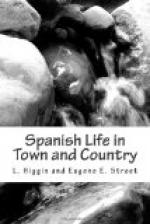These draught oxen are beautiful animals, mostly a deep cream in colour, with dark points, magnificent eyes, and a sphinx-like look of patience, as if biding their time for something much better to come. Their harness is not apparently irksome to them, and is not so heavy as one sees on the Portuguese oxen, for instance. They are coupled by a wooden bar across the head, and their driver, if such he can be called—rather, perhaps, the guide—walks in front with a long stick, possibly a wand of office, over his shoulder to show them the way. The dress of this functionary is picturesque: a wide-brimmed hat (sombrero), a shirt, short trousers to the knees, with gaiters of woven grass (esparto), a faja round his waist, and manta thrown over his shoulder if cold. He stalks majestically along, followed by his equally majestic bueyes, and one wonders of what all three are thinking as they trudge along the sun-smitten roads, regardless of dust or of anything else. The cars are rude enough, and the wheels sometimes solid discs of wood. Occasionally, a hood of bent pieces of wood covered with linen is fixed. Tame oxen, or cabestros, as they are called, play a very important part in the ganaderos and the bull-rings. They appear to be held in some sort of superstitious reverence, or strange affection, by the poor beasts who only live to make sport for men. In driving the bulls from one pasture to another, or bringing them into the towns, the cabestros are followed with unwavering faith by these otherwise dangerous animals; where the cabestro goes, clanging his great bell, the bull follows, and while under the charge of his domesticated friend he is quite harmless.
[Illustration: BUEYES RESTING]
At one time, the bulls used to be driven to the bull-ring outside Madrid in specially made roads sunk some fifteen feet below the level of the fields, and paved. Along these the pastor, or shepherd, and picadores, armed with long lances, went with the cabestros and the herd of bulls to be immolated. I have frequently met this procession when riding, either in the early morning or late evening, outside Madrid; but so long as the cabestros are present, there is nothing to fear, for the bulls are perfectly quiet and harmless. Once, however, riding with a friend, I had a disagreeable and exciting adventure. We were quietly walking our horses along the Ronda de Alcala, when we heard an immense amount of shouting, and suddenly became aware that we ourselves were the objects of the excitement, waving of hands, screaming, and gesticulating. Before we had time to do more than realise that we were being warned of some terrific danger in wait for us round the corner of the high wall, some little distance in advance, two picadores on horseback, armed with their long pikes, galloped round the corner, also shouting wildly to us, and pointing across the fields as if telling us to fly,




